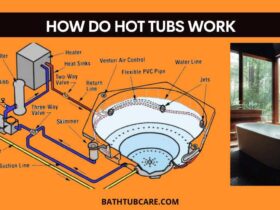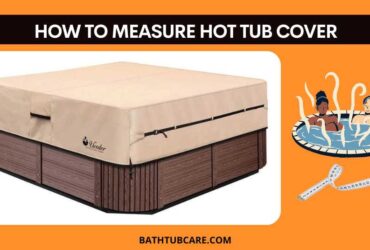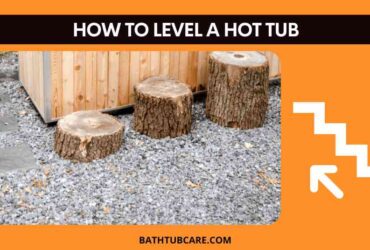How To Remove Calcium From Hot Tub Without Draining It
A clean and inviting hot tub is a delightful retreat for relaxation and rejuvenation, but dealing with calcium buildup can be a hassle. While draining the hot tub is a common solution, it’s time-consuming and wasteful. Fortunately, there are effective ways to tackle calcium deposits without the need for a full water change. By understanding the causes of calcium scaling and implementing targeted removal techniques, you can enjoy crystal-clear water without draining your hot tub. Let’s explore the best practices for removing calcium from your hot tub efficiently.
Understanding Calcium Buildup in Hot Tubs
Calcium buildup in hot tubs, also known as calcium scaling, occurs due to high levels of calcium in the water. This leads to the formation of white flakes or deposits on spa surfaces. Common sources of calcium in hot tub water include hard water and existing calcium deposits. If left unchecked for a long period of time, calcium scaling can damage the spa shell and plumbing, necessitating costly repairs. Regular testing of pH levels and total alkalinity is crucial to prevent and manage calcium buildup.
Problems Of Calcium Scaling
Calcium scaling in hot tubs poses several challenges. The most notable issue is the unsightly white flakes that accumulate on surfaces, causing a rough texture on spa shells. This buildup can lead to clogged filters, reduced water flow, and decreased efficiency of the heating system. Additionally, if left untreated, calcium scaling can damage the plumbing and other components of the hot tub, resulting in costly repairs. Proper maintenance and timely removal of calcium deposits are crucial to avoid these problems.
How Does Calcium Scale Form?
Calcium scale forms when calcium in the water combines with other elements, usually due to high water temperatures. This reaction causes the calcium to precipitate out of the water and adhere to surfaces, forming scale deposits. Understanding this process is crucial for effective hot tub maintenance.

Common Sources of Calcium in Hot Tub Water
One common source of calcium in hot tub water is the makeup water used to refill the tub. This water often contains dissolved minerals, including calcium, which can contribute to calcium buildup over time. Additionally, using hard water for hot tub maintenance can introduce more calcium into the water. Other sources include the chemicals and additives used in water maintenance, which may inadvertently add to the calcium levels. Monitoring and addressing these sources are key to managing calcium levels in your hot tub effectively.
Importance of Draining and Refilling the Hot Tub Periodically
Regularly draining and refilling your hot tub is crucial to maintain optimal water quality. Over time, hot tub water accumulates contaminants and minerals like calcium, affecting the pH level and total alkalinity. Draining the hot tub allows for a fresh start, preventing the buildup of harmful elements that can lead to issues with the equipment and an unpleasant spa experience. By refilling the hot tub periodically, you ensure a clean and safe environment for relaxing soaks. Proper maintenance enhances the longevity of your hot tub and promotes a healthier spa lifestyle.
Preparing to Remove Calcium Deposits
Before tackling calcium deposits, gather vinegar, baking soda, scrubbing tools, gloves, and safety goggles. Adequate ventilation is crucial for this task. Protect surrounding surfaces from potential splashes during the cleaning process. Safety precautions are key when working with chemical solutions. Be mindful of the tools needed and ensure a safe environment before starting the cleaning process. Stay cautious and prepared to effectively remove calcium deposits without draining your hot tub.
Tools and Materials You Will Need
To tackle calcium removal without draining, gather vinegar, baking soda, a soft-bristled brush, and a clean cloth. Ensure safety with gloves and goggles.
Safety Precautions Before Starting
Before tackling calcium removal in your hot tub, prioritize safety. Wear protective gloves and goggles to shield your skin and eyes from any cleaning solutions. Work in a well-ventilated area to avoid inhaling fumes. Ensure all hot tub equipment is turned off before starting the cleaning process to prevent accidents. Familiarize yourself with the tools and materials needed to handle the task effectively and safely. Taking these precautions will help you maintain a safe environment while removing calcium buildup from your hot tub.
Best Methods to Removing Calcium Without Draining
Using a vinegar and baking soda solution is an effective method to tackle calcium buildup in hot tubs. Scrubbing techniques can also aid in removing stubborn deposits. Consider utilizing commercial calcium removers or a hot tub vacuum for loose deposits for a comprehensive clean. These methods can help maintain a calcium-free environment without the need to drain the hot tub regularly, ensuring your spa water remains pristine and enjoyable.

Remove Calcium Flakes Using Vinegar and Baking Soda Solution
To combat calcium buildup in a hot tub without draining it, consider using a vinegar and baking soda solution. This natural remedy can help dissolve the stubborn calcium deposits effectively. Start by mixing equal parts of white vinegar and water, then apply the solution to the affected areas. Let it sit for some time to break down the calcium deposits, making it easier to scrub them off. This method is gentle yet efficient, ensuring a clean and scale-free hot tub without the need for a full water replacement.
Clean calcium buildup in hot tub with Bleach and Dishwasher Detergent Rinse
The process of removing calcium from a hot tub with a combination of bleach and dishwasher detergent can be achieved through a technique known as adsorptive precipitation. This involves introducing the respective elements into the water system to impart an electrical charge on the calcium ions, thus creating an electrostatic force that facilitates the absorption of said ions onto the surface area of any given adsorbent material.
You can follow this easy steps :
- Bleach: Bleach can be used to remove calcium from a hot tub.
- Pour 1 cup of bleach into a bucket or container.
- Add enough water to make a thick liquid.
- Pour the bleach solution into the hot tub and wait 10 minutes.
- Remove the hot tub cover and let the bleach solution soak into the foam and tiles for 30 minutes.
- Rinse the hot tub with warm water and a mild dishwashing detergent.
Scrubbing Techniques to Remove Calcium Buildup
To effectively tackle calcium buildup in your hot tub, employing proper scrubbing techniques is essential. Utilizing a gentle abrasive, such as a soft brush or non-abrasive pad, can help loosen and remove the stubborn calcium deposits. Focus on areas where the buildup is prominent, like the water line or spa surfaces. A mixture of vinegar and water can aid in loosening the calcium for easier removal. Regularly incorporating these scrubbing techniques into your hot tub maintenance routine can ensure a clean and calcium-free spa environment.
Use Commercial Calcium Removers
To address stubborn calcium deposits, consider utilizing commercial calcium removers specially formulated for hot tub water maintenance. These products are designed to effectively dissolve and eliminate calcium buildup without the need for draining the hot tub. Simply follow the manufacturer’s instructions for the proper application of the calcium remover. Choosing a high-quality commercial remover can significantly ease the process of removing calcium from your hot tub, ensuring a clean and well-maintained spa experience.
Use a Hot Tub Vacuum for Loose Deposits
Using a hot tub vacuum for loose deposits is an efficient way to tackle calcium buildup in your hot tub. These vacuums are specially designed to remove debris and deposits without draining the water. By vacuuming the affected areas, you can effectively target and eliminate loose calcium particles, preventing further scaling. This method is particularly useful for maintaining clean and clear spa water without the need for a complete water change. Regular use of a hot tub vacuum can help in keeping your hot tub free from unsightly white flakes and potential damage.
Maintaining Calcium-Free Water
Maintaining calcium-free water in your hot tub is crucial for ensuring its proper functioning and longevity. Regular water testing is essential to monitor the calcium levels and take necessary actions to prevent scale formation. Water softeners can be highly effective in controlling calcium levels and preventing scale buildup. These products work by reducing the amount of minerals in the water, making it less prone to calcium deposits. By regularly testing the water and using water softeners, you can maintain calcium-free water in your hot tub and enjoy clean and clear spa experiences.
While you can use chemicals to remove calcium from your hot tub, it is best to clean it regularly to prevent the build-up in the first place. Here are some tips on how to clean your hot tub to prevent calcium build-up:
- Clean the filters regularly.
- Clean the cover monthly.
- Brush the walls and floor of the tub weekly.
- Run the jets for 10 minutes after each use.
- Add a water softener to your system.
Regular Water Testing and Balancing
Regular water testing and balancing play a vital role in maintaining the quality of your hot tub water and preventing calcium buildup. Using test strips, you can easily measure important parameters such as pH level and total bromine. It is recommended to test the water on a regular basis, ideally once a week, to ensure that the levels are within the desired range. If the pH level is too high, it can lead to increased calcium precipitation and scale formation. By regularly testing and balancing the water, you can prevent calcium buildup and maintain the optimal conditions for your hot tub.
Adjusting pH and Alkalinity for Calcium Control
Adjusting the pH and alkalinity levels in your hot tub is essential for effective calcium control. The pH level refers to the acidity or alkalinity of the water, while total alkalinity measures the ability of the water to resist changes in pH. To prevent calcium buildup, it is important to maintain the pH level between 7.2 and 7.8 and the total alkalinity between 80 and 120 ppm. If the levels are too high, it can lead to calcium precipitation and scale formation. Regularly monitoring and adjusting the pH and alkalinity levels can help maintain calcium-free water and prevent scale buildup in your hot tub.
Using Water Softeners Effectively
Water softeners can be highly effective in preventing calcium scale and maintaining the quality of your spa water. Hard water, which contains high levels of calcium and magnesium, is a common cause of calcium scale formation. By using water softeners, you can reduce the amount of minerals in the water and prevent scale buildup. These products work by exchanging the calcium and magnesium ions with sodium ions, effectively softening the water. Using water softeners in your hot tub can help keep the water free from calcium scale and ensure a clean and enjoyable spa experience.
Preventative Measures to Avoid Future Calcium Buildup
Taking preventative measures is essential to avoid future calcium buildup in your hot tub. One effective measure is using a scale preventer, which helps inhibit the formation of calcium deposits. Additionally, implementing a regular cleaning schedule can help remove any existing calcium buildup before it becomes a problem. Maintaining and optimizing the filtration system settings is also important, as it helps remove impurities and prevents calcium scaling. By incorporating these preventative measures into your hot tub maintenance routine, you can minimize the risk of calcium buildup and ensure the longevity of your spa.
Implementing a Regular Cleaning Schedule
Implementing a regular cleaning schedule is crucial for preventing calcium buildup in your hot tub. Cleaning your hot tub on a regular basis removes any existing calcium deposits and prevents further buildup. It is recommended to clean the hot tub at least once a month, or more frequently if you use it frequently or have a high bather load. This includes cleaning the shell, filters, and other components of the hot tub. Additionally, using a hot tub cover when not in use can help keep the water clean and reduce the risk of calcium buildup. By following a regular cleaning schedule, you can maintain a calcium-free hot tub and ensure optimal water quality for your spa experiences.
Using Scale Preventers in Hot Tub Maintenance
Scale preventers are an effective tool in hot tub maintenance to prevent calcium buildup. These products work by inhibiting the formation of calcium deposits, keeping the water free from scales. Using a scale preventer regularly can help maintain a calcium-free hot tub and reduce the need for frequent cleaning and scale removal. It is important to follow the manufacturer’s instructions when using scale preventers to ensure optimal results. By incorporating scale preventers into your hot tub maintenance routine, you can minimize the risk of calcium buildup and enjoy a clean and clear spa experience.
Optimizing Filtration System Settings
Optimizing the filtration system settings in your hot tub is essential for preventing calcium scaling and maintaining the quality of the spa water. The filtration system plays a crucial role in removing impurities and preventing the buildup of calcium deposits. It is important to set the filtration system to run for an adequate period of time to ensure effective water circulation and filtration. This helps prevent the accumulation of minerals and reduces the risk of calcium scale formation. By regularly maintaining and optimizing the filtration system settings, you can keep your hot tub water clean and prevent calcium buildup.
Conclusion
In conclusion, keeping your hot tub free from calcium buildup is essential for its longevity and your enjoyment. Regular maintenance, including using natural remedies like vinegar and baking soda, scrubbing techniques, and commercial calcium removers, can help prevent the formation of stubborn deposits. Remember to test and balance your water regularly, adjust pH levels, and consider using water softeners to keep calcium levels in check. By implementing preventative measures and a consistent cleaning schedule, you can ensure a relaxing and enjoyable hot tub experience without the need for frequent draining.
Frequently Asked Questions
What Causes Calcium Levels to Spike in Hot Tubs?
High pH and total alkalinity levels, as well as the presence of hard water, can cause calcium levels to spike in hot tubs. The use of lotions and other products can also contribute to calcium buildup in the water.
Can Vinegar Remove Calcium Deposits?
Vinegar can be an effective natural remedy for removing calcium deposits. Its acidic properties can help break down and dissolve the calcium deposits, making them easier to clean and remove from the hot tub surfaces.
How Often Should I Test My Hot Tub Water for Calcium?
It is recommended to test the hot tub water for calcium levels on a regular basis, ideally once a month or more frequently depending on usage. Using test strips or other water testing methods, you can monitor the calcium hardness and take necessary actions to prevent buildup.
Are There Any Natural Remedies for Calcium Removal?
Yes, there are natural remedies for calcium removal in hot tubs. Vinegar and baking soda can be used as effective and eco-friendly solutions to remove calcium deposits. Applying them with a little elbow grease can help break down and dissolve the calcium buildup.
Is Calcium Scaling harmful?
Calcium scaling can be harmful to spa surfaces and affect the overall water quality in your hot tub. It can cause damage to the surfaces and affect the user experience. Regular maintenance and prevention measures are important to avoid calcium scaling.













Leave a Reply